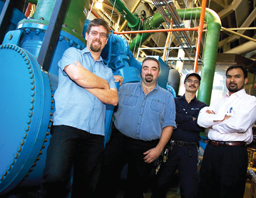Laura Eggertson

Two major “green” initiatives, whichare eliminating waste energy on campus, are also delivering huge savings to the University.
The first project circulates cool water that is needed to regulate the temperature in computer labs and research facilities. Using machines called “chillers” and an extensive system of steel pipes, located at the Power Plant, the waste energy — a byproduct of the cooling process — is simultaneously used to heat D’Iorio Hall. By transferring waste heat from one process to another and from one building to another, the University is putting energy that has already been bought and paid for, back to work.
“The heat that we’re putting back into D’Iorio is about five per cent of the natural gas we buy, so we’re saving five per cent of the campus heating bill with this, which is huge,” says Pierre de Gagné, the Physical Resources Service’s assistant director of engineering and sustainable development.
The waste heat recovery program, which began two and a half years ago, is twinned with the second initiative, which involves retro-fitting the comfort ventilation system in Fauteux Hall. A giant heat exchanger on the roof of Fauteux takes the heat leaving the building and recycles it, preheating the air that’s rushing into the building.
This heating and cooling initiative, saves about $400,000 a year in energy costs, says de Gagné. Since the project will cost about $1.8 million, it should pay for itself in just under five years, depending upon the price of energy.
In addition, the University is buying three new, more efficient pumps and optimizing layout to upgrade the water chilling system that lowers the temperature in buildings throughout the summer. The new pumps, which replace 40-year-old models, will help save 28 per cent of the energy costs involving pumping and cooling towers, de Gagné says.
“We’re getting some future capacity too, which will help us avoid capital expenditures later,” he says.
De Gagné, ably assisted by energy manager and alumnus (engineering) Faizal Sudoollah, is responsible for the energy efficiency of about 570,000 square metres of buildings on campus. These men are the latest in a long tradition of engineers employed at uOttawa, who make sustainability a priority. The University hired its first energy manager in 1974, and although the campus has almost tripled in physical size and student population since then, its energy consumption has stayed almost the same, de Gagné says, “because of all the retrofitting and changes we’ve made.”
In fact, since 1974 the campus’s direct emissions have decreased by 26 per cent, he says. And in the last 15 years, the University has saved $27 million in energy savings on fuel, electricity and water.
These impressive results are due to the work of de Gagné’s team and that of his counterpart Mario Boileau, who leads the technical services, operation and maintenance side of the Physical Resources Service.
If the two teams did not work so closely together, they wouldn’t have the savings they generate, says de Gagné. “We may not be Dofasco, but the people here are really important,” he says.